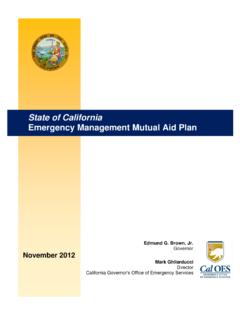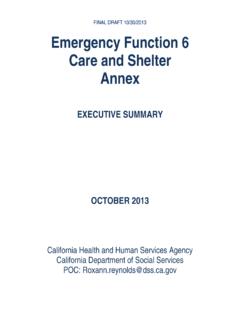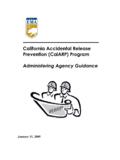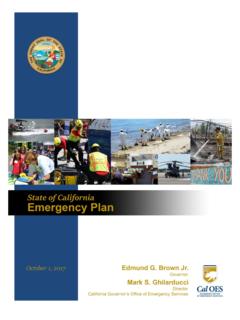Transcription of California State Emergency Plan 2017
1 This Page Intentionally Left Blank OFFICE OF THE GOVERNOR. October 1, 2017. To: Heads of All State Departments, Offices, and Agencies Heads of City and County Governments People of the State of California This updated Emergency plan represents the collective effort of Emergency services professionals to protect our people, our infrastructure, and our environment against all threats, natural or human caused. This plan considers the effects of climate change on Emergency management and homeland security. As seen recently, climate change has greatly exacerbated floods, wildfires, drought, and other extreme weather events.
2 The ever-lasting threats of destructive earthquakes and acts of terrorism further complicate our mission and underscore the need for comprehensive readiness and resilience. With deliberate preparation, rapid response and recovery, and government and private industry working together, I am confident that California can withstand the effects of emergencies and disasters now and into the future. Sincerely, iii This Page Intentionally Left Blank iv EDMUND G. BROWN JR. MARK S. GHILARDUCCI. GOVERNOR DIRECTOR. October 1, 2017. To: Heads of All State Departments, Offices, and Agencies Heads of City and County Governments People of the State of California Protecting the people of California , its resources, and critical infrastructure is a core responsibility of government.
3 Effective Emergency response requires a united effort which is reflected in this updated State of California Emergency Plan. As the Director of the California Governor's Office of Emergency Services, I am charged with executing this Plan under Emergency conditions and continuing its development as experience or changing conditions require. This Plan includes revisions and enhancements to clearly communicate how State government mobilizes and responds to emergencies and disasters in coordination with partners in all levels of government, the private sector, non-profit, and community-based organizations.
4 It also works in conjunction with the California Emergency Services Act and outlines a robust program of Emergency preparedness, response, recovery, and mitigation for all hazards, whether natural or human caused. I request that all political subdivisions of California take the necessary steps to carry out the provisions of this Plan in their jurisdictions to protect our great State and its people. Sincerely, MARK S. GHILARDUCCI. Director v This Page Intentionally Left Blank vi 1. Foreword California is a leader in preparing for emergencies and disasters, both natural and human-caused.
5 The State 's role in Emergency management dates back to the early 20th century when catastrophic events such as the 1906 San Francisco earthquake highlighted California 's significant disaster risk. Today, terrorist threats and actions around the world compound the need for readiness beyond natural disasters. Here's a brief look at California 's history of Emergency management . 1917 State Council of Defense created by the State Legislature to address public security, public health, economic resource development, and military training. 1929 State Emergency Council was formed to plan for potential future emergencies.
6 1933 Field Act of 1933 following the Long Beach earthquake marked a significant step in the advancement of earthquake-resistant building design. 1943 State War Powers Act was created by the Legislature and divided the civilian war effort into two segments: protective services and war services. The Act also established the California State War Council that assigned certain activities to State agencies. 1945 California Disaster Act enacted by the State Legislature. This combined responsibility for planning and preparing for emergencies, whether natural, technological, or human- caused, into a single State agency.
7 During the period from 1945 to 1970 the agency was known variously as the Office of Civil Defense (1950) and California Disaster Office (1956), and functioned under the authority of the California Disaster Act. 1950 California Civil Defense and Disaster Relief Plan and California Disaster and Civil Defense Master Mutual Aid Agreement. The relief plan was the first comprehensive Emergency plan developed by the State . While its main focus was civil defense, it contained annexes relating to natural disasters. The California Disaster and Civil Defense Master Mutual Aid Agreement under Governor Earl Warren was adopted that same year.
8 It remains to this day a cornerstone of California 's Emergency management system. 1970 California Emergency Services Act (ESA) was enacted to supersede the California Disaster Act. The new Act established the Governor's Office of Emergency Services with a Director reporting to the Governor. The office was given responsibility of coordinating statewide Emergency preparedness, post Emergency recovery and mitigation efforts, and the development, review, approval, and integration of Emergency plans. 1974 Natural Disaster Assistance Act (NDAA) authorized the Director of the California Governor's Office of Emergency Services to administer a disaster assistance program that provides financial assistance from the State for costs incurred by local governments as a result of a natural disaster event.
9 The program also provides for the reimbursement of local government costs associated with certain Emergency activities. In 2002, the Act was vii amended to allow funding for terrorist acts and epidemics, and renamed the Disaster Assistance Act (DAA). The Act was again amended in 2005 to change certain definitions of qualifying projects and renamed the California Disaster Assistance Act (CDAA). 1990 Americans with Disabilities Act (ADA) prohibits discrimination against individuals with disabilities in all areas of public life, including jobs, schools, transportation, and all public and private places that are open to the general public.
10 The ADA guarantees that people with disabilities have the same opportunities as everyone else to participate in the mainstream of American life. 1996 Standardized Emergency management System (SEMS) resulted in a major revision of the California Emergency Services Act. With the Incident Command System at its foundation, SEMS emphasizes a standard organizational structure and terminology at all Emergency management levels. The system was designed to enhance coordination among response organizations, and facilitate the flow of Emergency information and resources within and between the organizational levels.










